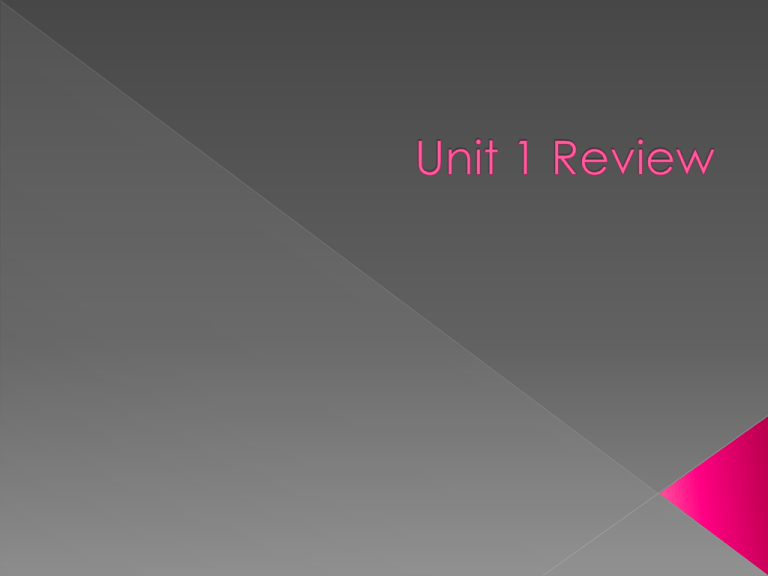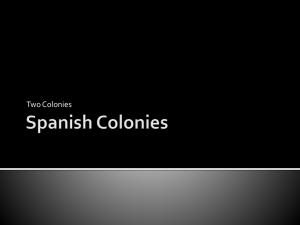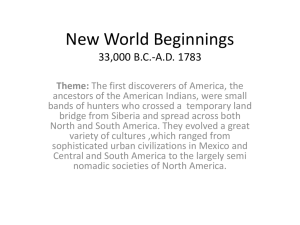Unit 1 Review - loudoun.k12.va.us
advertisement

Which of the following does not involve relations between Indians and colonists in New England? A) Squanto assisting the Plymouth Separatists B) King Philip's (or Metacom's) War C) "praying towns" D) the Powhatan Confederacy E) Pequot War D) the Powhatan Confederacy Explanation: Powhatan, the father of Pocahantas, was the Indian leader of a group of tribes in the tidewater region of colonial Virginia. Squanto's assistance, King Philip's War, "praying towns," and the Pequot War all involve relations between Indians and colonists in New England. “For we must consider that we shall be as a city upon a hill. The eyes of all people are upon us. So that if we shall deal falsely with our God in this work we have undertaken... we shall be made a story and a by-word throughout the world. We shall open the mouths of enemies to speak evil of the ways of God... We shall shame the faces of many of God's worthy servants, and cause their prayers to be turned into curses upon us til we be consumed out of the good land whither we are a-going.” A) B) C) D) E) William Penn William Bradford Roger Williams John Winthrop John Smith D) John Winthrop Explanation: While still on board the Arbella which had brought Winthrop, Puritans, and others to Massachusetts Bay Colony in 1630, he read his famous "city upon a hill" sermon in which he characterized the Puritans as providing a moral beacon for the world. American leaders, most recently President Ronald Reagan, have adopted Winthrop's message in their promotion of American exceptionalism. President John Kennedy, just before his inauguration in 1961, pointed to Winthrop's model when he wrote "For we are setting out upon a voyage in 1961 no less hazardous than that undertaken by the Arbella in 1630. We are committing ourselves to tasks of statecraft no less awesome than that of governing the Massachusetts Bay Colony, beset as it was then by terror without and disorder within. History will not judge our endeavors—and a government cannot be selected—merely on the basis of color or creed or even party affiliation. Neither will competence and loyalty and stature, while essential to the utmost, suffice in times such as these. For of those to whom much is given, much is required." A) a group of Virginia colonists, unhappy with the presence of Indians in the colony, attacked various Indian tribes, burned down the capital of Jamestown and forced the royal governor and his troops to flee B) a charismatic black preacher inspired a slave uprising that resulted in the deaths of 56 whites in Virginia C) promised their freedom by the Spanish governor of Florida, a group of mostly Catholic slaves organized a rebellion in South Carolina D) a group of vigilantes living in Pennsylvania murdered 20 Indians following the French & Indian War E) 26 slaves were hanged upon discovery of plans of a revolt in Virginia organized by a slave named Gabriel C) promised their freedom by the Spanish governor of Florida, a group of mostly Catholic slaves organized a rebellion in South Carolina Explanation: The 1739 Stono Rebellion was the largest slave uprising in the British American colonies. A group of about 20 slaves seized arms, marched south towards Florida and were eventually captured or killed. The revolt resulted in the deaths of over 100 whites and blacks and led to the passage of the 1740 Negro Act limiting the privileges of slaves. Other choices: A)Bacon's Rebellion; B) Nat Turner's Revolt; D) Paxton Boys; E) Prosser's (or Gabriel's) Rebellion. Of the following colonies, which was established by Cecil Calvert and became known as a religious refuge for Roman Catholics? (A) (B) (C) (D) (E) Pennsylvania Maryland Rhode Island Georgia Connecticut (B) Maryland Explanation: Cecil Calvert, also known as Lord Baltimore, received a charter from King Charles I for Maryland in 1632, though he never visited his colony. Maryland practiced religious toleration and was viewed as a refuge for Catholic immigrants, particularly during the reign of the Puritans and Oliver Cromwell in England. The Maryland Toleration Act of 1649 guaranteed religious freedom for Christians. Which of the following, while searching for the Northwest Passage, was set adrift with his son by mutinous crew members and disappeared without a trace in 1611? A) B) C) D) E) John Cabot Alexander Mackenzie William Parry John Franklin Henry Hudson E) Henry Hudson Explanation: The British government and scientific organizations funded a number of voyages in search of the Northwest Passage from the 17th to the 19th centuries. Many ended tragically, including Henry Hudson's 1610-11 adventure. Following a season of exploring, Hudson wanted to continue, but members of his crew set him off in a small boat with his teenage son and six loyal crew members. The mutineers returned to England but were never tried for their mutiny. A) she was banished from the Massachusetts Bay Colony B) she was accused of teaching both men and women in her home C) when on trial, she admitted to receiving divine revelation from God for her beliefs D) she was accused of preaching Quaker doctrines E) she and most of her family were eventually killed by Indians in 1643 D) she was accused of preaching Quaker doctrines Explanation: Anne Hutchinson took a courageous stand when confronted by the political and religious authorities in Massachusetts Bay. She was put on trial for what were considered her heretical beliefs and accused of criticizing the Puritan ministers as well as teaching both men and women in Bible studies in her home. She was expelled from Massachusetts Bay in 1638. In her trial testimony she stated to the court "...you have no power over my body, neither can you do me any harme, for I am in the hands of the eternall Jehovah my Saviour, I am at his appointment, the bounds of my habitation are cast in heaven, no further doe I esteeme of any mortal man than creatures in his hand, I feare none but the great Jehovah, which hath foretold me of these things, and I doe verily beleeve that he will deliver me out of our hands, therefore take heed how you proceed against me; for I know that for this you goe about to doe to me, God will ruine you and your posterity, and this whole state." I. the headright system which increased land ownership II. allowing for the export of tobacco to England III. limiting land ownership to members of the Church of England IV. providing a representative assembly A) I and II only B) II, III, and IV only C) I, II, and IV only D) all of the above E) none of the above C) I, II, and IV only Explanation: Though the first colonists in Virginia had to survive starvation and Indian attacks, by the middle of the 17th century Virginia was a thriving colony. The headright system provided 50 acres of land for each immigrant and 50 more for each indentured servant brought from England. Tobacco proved to be a hugely successful crop and the House of Burgesses, established in 1619, provided a form of selfgovernment that encouraged settlement. The most profitable economic activity of New France was A) B) C) D) E) lumber production fur trading silver mining fishing shipbuilding B) fur trading Explanation: While fishing cod was the first profitable activity in French colonies in North America, fur-trading (particularly of beaver) soon became the dominant occupation of colonists. Dutch and British interests competed with the French furtraders who established extensive trading relationships with a number of Indian tribes. What was the system used by Spanish colonial leaders that kept Indians working in mines and fields in almost slave-like conditions? A) B) C) D) E) seigneur and habitant hacienda mayordomía or cargo system cofradías encomienda E) encomienda Explanation: The encomienda system granted control of a group of natives to an individual who was expected to protect them from warring tribes. In exchange, they could exact tribute from the Indians in the form of labor, food, or precious metals. Soldiers, conquistadors, and officials were granted encomiendas, which often were run in a corrupt and cruel manner. Its excesses were exposed in the writings of Father Bartolomé de las Casas and it was eventually eliminated in Spanish America. A) they lived on the west coast of Mexico B) their writing system used over 1000 glyphs or phonetic symbols C) they used pulleys, wheels, and other sophisticated engineering techniques in the construction of pyramids D) their culture developed very little art in contrast to other American Indian cultures E) their diet consisted mostly of potatoes B) their writing system used over 1000 glyphs or phonetic symbols Explanation: The Mayans lived on the Yucatan Peninsula and the neighboring regions of what are now Guatemala, Belize, Honduras, and Mexico. Their massive stepped pyramids were built without the benefit of wheels or pulleys and required enormous numbers of workers to complete. Mayan art is among the most sophisticated of all Indian groups, featuring pottery, statuary, and murals. The diet of the Mayans consisted mainly of corn, beans, and squash. The eastern woodlands Indians, who lived roughly in the area between the Mississippi River and the Atlantic coast, featured all of the following except A) large ceremonial mounds in several locations B) a peaceful, non-warlike relationship with neighboring tribal groups C) a hunting-gathering culture, sometimes moving on a seasonal basis D) a complex social system typically divided into classes, with a chief, his children, nobles and commoners E) wigwams and longhouses covered with tree bark B) their writing system used over 1000 glyphs or phonetic symbols Explanation: The Mayans lived on the Yucatan Peninsula and the neighboring regions of what are now Guatemala, Belize, Honduras, and Mexico. Their massive stepped pyramids were built without the benefit of wheels or pulleys and required enormous numbers of workers to complete. Mayan art is among the most sophisticated of all Indian groups, featuring pottery, statuary, and murals. The diet of the Mayans consisted mainly of corn, beans, and squash. A) the Sioux of the plains B) the Iroquois of the eastern woodlands C) the Chumash of the California Coast D) the Kwakiutl of the Pacific Northwest E) the Hohokam of the Southwest E) the Hohokam of the Southwest Explanation: The Hohokam people built canals and irrigation ditches that stretched through what is now Arizona. Some required years of digging with primitive hand tools and were up to twelve miles in length. The Hohokam settlements were abandoned some time in the 1400s. A) Francisco Pizarro and 180 men captured and killed Incan king Atahualpa who commanded an army of 80,000 soldiers B) the main crop of the Incas was potatoes which were grown on terraces in the mountainous terrain of the Andes C) the Incas used a knotted rope system, known as quipu, to record information D) originating in the Andes Mountains, the Incan empire spread throughout South and Central America by the arrival of the Spanish in the 1520s E) the Incas comprised the largest empire in preColumbian America D) originating in the Andes Mountains, the Incan empire spread throughout South and Central America by the arrival of the Spanish in the 1520s Explanation: The Incans had the largest empire in preColumbian America, located along the Andean region on the west coast of South America. Despite greatly outnumbering the Spanish under Pizarro's leadership, Incan king Atahualpa became a prisoner, offered huge amounts of gold and silver as a ransom, and was eventually killed by the Spanish. Unlike the maize raised by Mayans and Aztecs, Incans farmed potatoes as their main crop. They also used an elaborate rope-and-knot system for some form of record-keeping. Almost 500 years before Columbus arrived in the New World in 1492, Norsemen became the first Europeans to reach North America, landing in Newfoundland in the year around the year 1000. Which of the following statements about their adventure is accurate? A) it resulted in a thriving colony that traded extensively with Indian tribes along the East Coast B) explored by the Norsemen, the land known as Vinland was probably first spotted around 986 by Bjarni Herjulfsson who refused his crew's request to go ashore C) extensive archaeological remains of the colony exist today at a number of locations D) the only sign of the Norsemen's presence was the word "CROATAN" written on a tree E) historians believe only men were present on the voyage B) explored by the Norsemen, the land known as Vinland was probably first spotted around 986 by Bjarni Herjulfsson who refused his crew's request to go ashore Explanation: Leif Ericson is credited with the first European visit to the New World, though the impact of his Norsemen settlers was insignificant and short-lived. He had heard of Vinland from Herjulfsson and led a colonizing group of unknown size, which the limited archaeological evidence that has been found suggests included women as well as men. "CROATAN," written on a tree, was the only record left by a group of missing English settlers on Roanoke Island in Virginia in 1585.






